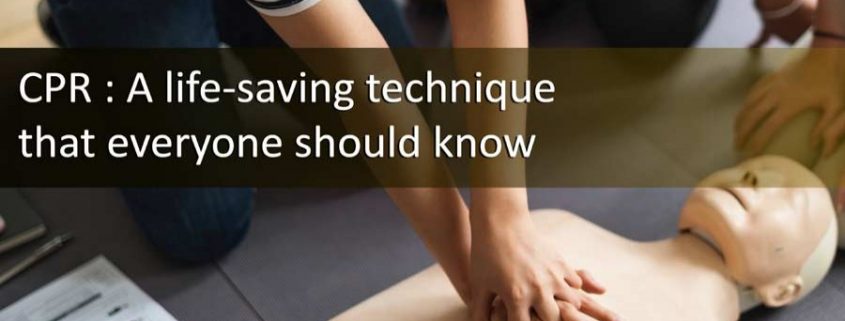CPR: A life-saving technique that everyone should know
On a busy road in downtown Dhaka, Tarannum, sitting on her scooter and waiting for the traffic lights to turn green, suddenly she fell off and lay crumpled on the road. Sensing an emergency, Tara, who was passing by, ran towards her and administered CPR, keeping as calm as possible while trying to revive Tarannum. Eventually, when the paramedics arrived, they told Tara that she had helped save a life as Tarannum had a cardiac arrest. Tara was just thankful that she was at the right place, at the right time. A flight attendant by profession, Tara had received several hours of emergency training which she put to good use in what was definitely a life and death situation that day.
In another incident, while playing in her elementary school, little Parveen suddenly slumped to the ground and was unresponsive. Her friends ran for help. A staff member who found that Parveen had no pulse and wasn’t breathing, performed CPR as an emergency dispatcher took her through the steps over the phone. Soon, it was determined that Parveen had gone into a seizure, resulting in fainting spells. Subsequently at the hospital, she was stabilised when a cardioverter defibrillator was implanted in her chest. The staff member at the school emerged a hero because she dispensed the life-saving CPR.
But what exactly is CPR? Read on…
Cardiopulmonary Resuscitation (CPR): A bridge between life and death
CPR, or cardiopulmonary resuscitation, is what helped save Tarannum and Parveen’s life. After having analysed hundreds of thousands of emergency cases over the years, experts have come to the undeniable conclusion that if a bystander performs CPR, the outcome for the recipient will often be the difference between life and death. On an average, it has been estimated that paramedics can take anywhere between 8 to 10 minutes to arrive at the emergency scene, with this time extending by much more in crowded cities and areas. Research has also proved that each minute that someone goes without chest compressions, which forms the foundational basis of resuscitation, their chance of survival goes down by as much as 10 per cent. Hence, CPR is a strong transitional emergency response in the intervening time when the patient goes into an attack till the time professional help arrives.
It is an irony that though anyone can learn the technique governing CPR – yes, it is quite simple, yet many are unaware of this basic life-saving procedure. On the other hand, after having learnt the procedure, many individuals have reported that they have felt empowered by their knowledge of the practice and believe that they are in a better position to handle emergencies. With lifestyle-driven cardiac ailments increasing the world over, especially in developing countries, administering CPR should not only be considered to be under the purview of the healthcare fraternity, but for anyone who wants to act with responsibility and speed in crisis situations to make a difference. Hence, experts recommend that the techniques of CPR should be made a part of the school curriculum.
Administering CPR
If one witnesses a cardiac arrest, it’s crucial to call emergency services and start CPR immediately. CPR represents a simple 6-step process.
>>Step 1: Shaking and shouting
>>Step 2: Checking for normal breathing
>>Step 3: Calling emergency response
>>Step 4: Dispensing 30 chest compressions
>>Step 5: Giving two rescue breaths
>>Step 6: Repeating the process until professional help arrives (paramedics / ambulance)
Step 1: Shaking and shouting
If you come across someone who is unconscious, you should always check for danger and look for risks before you start helping. With regards to checking for a response, you can gently shake the person’s shoulders, while asking loudly if they are alright. The golden rule: Never panic and call for help from those around you. However, never leave the person alone.
Step 2: Checking for normal breathing
Someone having a cardiac arrest will either not be breathing or will not be breathing normally. They also will not be conscious. In this situation, keep their head back and check if the person is breathing normally by looking for:
- Regular chest movements
- Listening for sounds of breathing
- Feeling for breath on your fingers
Look, listen and feel for not more than 8-10 seconds. Also, it is important that you not confuse gasps with normal breathing. If you’re not sure if their breathing is normal, act as if it’s not normal. If you are certain that the person is breathing normally, then put them in the recovery position and dial emergency. However, if the breathing isn’t normal, you must focus on opening their airway. For this, you should place one hand on the person’s forehead, gently tilt their head back, then lift their chin using two fingers of your other hand under their chin. When you do this, you open up their airway.
Step 3: Calling emergency response
If the person is not breathing or not breathing normally, ask someone to call emergency response immediately to ask for an ambulance. However, if no one is in sight to help, you should call emergency without delay before administering CPR.
Step 4: Dispensing 30 chest compressions
Kneel next to the person. Thereafter, place the heel of one hand in the centre of their chest. Place your other hand on top of the first. Interlock your fingers. With arms straight, use the heel of your hand to push the breastbone down firmly and smoothly so that the chest is pressed down between 5–6 cm. Release after doing so. Do this in a loop at the rate of about 100 to 120 chest compressions per minute. This works to about 2 per second. Keeping a count will help.
Step 5: Giving two rescue breaths
Open the airway again by tilting the head back and lifting the chin. Pinch the soft part of the person’s nose closed. Take a normal breath, make a seal around the person’s mouth and breathe-out steadily. Doing so would make the person’s chest rise and fall. Keeping the person’s head back and the chin lifted, take your mouth away, take another normal breath and give a second rescue breath. The two breaths should take no longer than five seconds. Again, keeping a count would help.
Step 6: Repeat the process until professional help arrives
Repeat the 30 compressions and two rescue breaths. If you’d rather not give rescue breaths, you can also call emergency response and deliver hands-only CPR. One should keep calm until professional help arrives and takes over, or the person starts to show signs of regaining consciousness, such as coughing, opening their eyes, speaking or breathing normally.
Now that the process of CPR is demystified, we hope you are able to cope with emergency situations. After all, there’s no bigger gratification than saving someone’s life!
GD Assist
Hotline: 16457; +8801617666888. Email: gdal@green-delta.com
Website: gdassist.com




